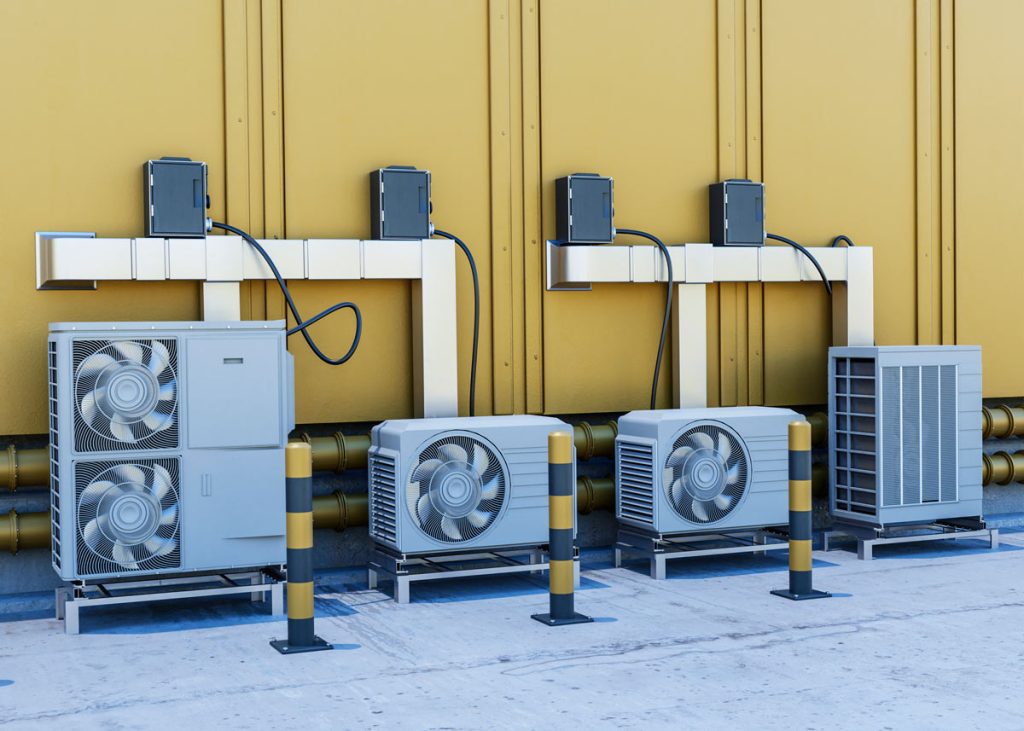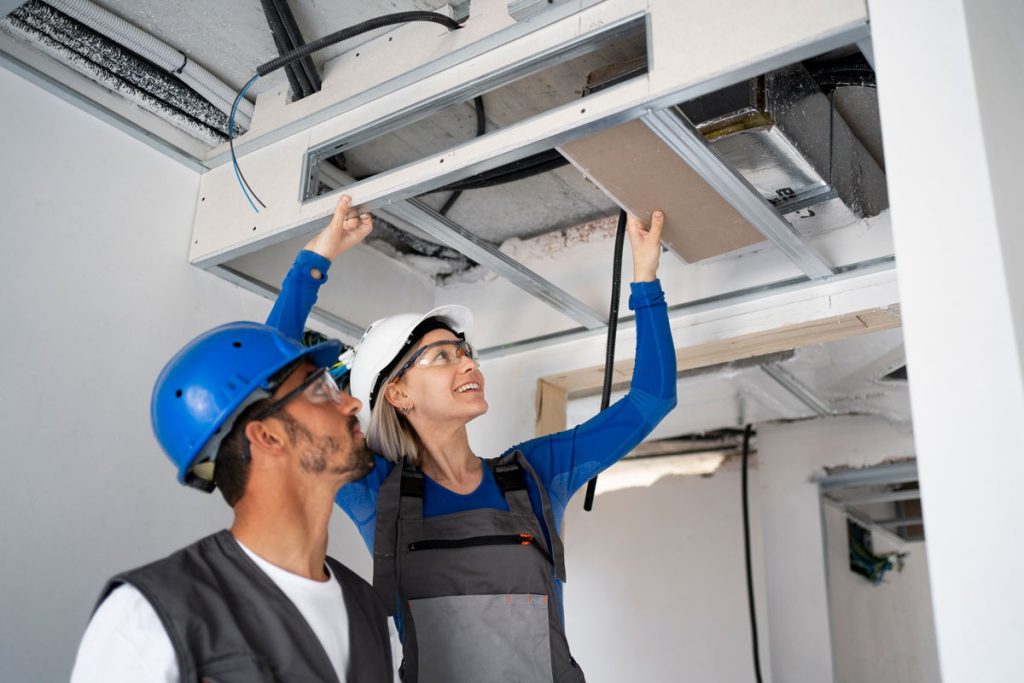Temperature control is a critical aspect of managing energy consumption in Heating, Ventilation, and Air Conditioning (HVAC) systems. Traditionally, thermostats have been used to manage this, but in larger buildings such as offices, restaurants, and warehouses, achieving uniform temperature control can be challenging. This is where HVAC zoning steps in, offering a solution to efficiently manage energy use and temperature control across different areas of the property.
Large commercial buildings often face high energy costs, with HVAC systems being a significant contributor. By implementing HVAC zoning, these buildings can see substantial savings on their energy bills. This article will explore how HVAC zoning works, its benefits for offices, restaurants, and warehouses, common pitfalls to avoid, and answer frequently asked questions to help you make an informed decision.
Ready to Save on Energy Costs? Call Hood Builder at 800-750-7055 for a free consultation on implementing HVAC zoning in your office, rrestaurant or warehouse.
Understanding HVAC Zoning: How It Works in Large Buildings
HVAC zoning is a method that divides a building into multiple distinct areas, or zones, each with its own temperature control system. This allows for precise management of heating and cooling in different parts of the building, optimizing energy use and enhancing comfort.
The process of implementing HVAC zoning typically involves several steps:
- Design and Plan: Assess the building’s layout, usage patterns, and existing HVAC infrastructure to determine the optimal number and configuration of zones.
- Install Motorized Dampers: These are placed in the ductwork to control the flow of air to each zone. They can open and close to direct air where it’s needed.
- Setup Multiple Thermostats: Each zone has its own thermostat, allowing independent temperature control.
- Configure the Control Panel: This central unit coordinates the operation of the dampers and thermostats to ensure that each zone receives the appropriate amount of heating or cooling.
- Test and Balance: After installation, the system is tested to ensure that each zone is functioning correctly and that the air distribution is balanced.
It’s crucial to engage with professional HVAC technicians throughout this process to ensure that the system is designed and installed correctly, minimizing disruptions to your business and ensuring long-term efficiency.
Additionally, regular maintenance is essential to keep the zoning system operating at peak performance. Familiarizing yourself with local regulations and seeking professional advice can help avoid any compliance issues.
Key Benefits of HVAC Zoning for Offices, Restaurants, and Warehouses

HVAC zoning offers several significant advantages for large commercial buildings such as offices, restaurants, and warehouses:
- Energy Efficiency: By allowing precise control over temperature in different zones, HVAC zoning reduces energy waste. Areas that are not in use or have different temperature requirements can be managed separately, leading to significant savings. Studies suggest that energy savings from HVAC zoning can range from 10% to 30%, depending on the building and system specifics, as seen in Energy Efficiency with Zoning.
- Enhanced Comfort: Different parts of a building may have varying temperature needs based on usage, occupancy, or exposure to external conditions. Zoning ensures that each area maintains its desired temperature, providing optimal comfort for occupants.
- Reduced Wear on Equipment: With zoning, the HVAC system doesn’t have to work as hard to maintain uniform temperatures throughout the entire building. This reduced workload can lead to less frequent repairs and a longer lifespan for the equipment.
- Cost Savings: Lower energy consumption directly translates to reduced utility bills, making HVAC zoning a financially beneficial investment for large properties.
While the initial investment for HVAC zoning may be substantial, the long-term savings in energy costs and maintenance expenses make it a prudent choice for offices, restaurants, and warehouses, where energy consumption is typically high.
Common Mistakes to Avoid When Implementing HVAC Zoning Systems
Implementing an HVAC zoning system can be complex, and there are several common mistakes that building owners should avoid to ensure the system’s effectiveness and efficiency.
- Rushed or Faulty Planning: Proper planning is crucial. Failing to assess the building’s layout, usage patterns, and existing HVAC capabilities can lead to a system that doesn’t meet the building’s needs. For example, creating zones that don’t align with how the building is used can result in inefficient temperature control.
- Incompatibility with Current Systems: Ensuring that the new zoning system is compatible with the existing HVAC equipment is essential. Older systems may not support zoning, or additional modifications may be needed, which could increase costs and complexity.
- Ignoring Regular Maintenance: Like any HVAC system, zoned systems require regular maintenance to function optimally. Neglecting this can lead to decreased performance, higher energy consumption, and potential system failures.
- Neglecting Professional Inspections: It’s important to have the system inspected by professionals after installation to ensure it’s working as intended. This can help identify and correct any issues early on, preventing more significant problems down the line.
- Setting Up Too Many or Too Few Zones: The number of zones should be carefully determined based on the building’s specific needs. Too many zones can complicate the system and increase costs, while too few may not provide the desired control and energy savings.
Here’s a table summarizing these mistakes and their solutions for clarity:
| Mistake | Impact | Solution |
| Rushed or Faulty Planning | Inefficient zoning, higher costs | Assess layout, consult professionals |
| Incompatibility with System | Reduced efficiency, potential damage | Check compatibility, upgrade if needed |
| Ignoring Maintenance | System wear, higher bills | Schedule regular inspections, clean dampers |
| Neglecting Inspections | Hidden issues, safety risks | Hire professionals for post-installation checks |
| Too Many/Few Zones | Uneven comfort, energy waste | Balance zones based on usage and building size |
By being aware of these potential pitfalls and taking steps to avoid them, building owners can maximize the benefits of their HVAC zoning system.
How to Implement HVAC Zoning Successfully

Implementing an HVAC zoning system requires a systematic approach to ensure it meets the building’s needs and operates efficiently. Here are the key steps to follow for a successful implementation:
1. Assessment and Planning:
- Evaluate the building’s layout, usage patterns, and existing HVAC system.
- Determine the number and configuration of zones based on temperature requirements and occupancy patterns.
- Consider factors such as solar exposure, insulation, and the type of activities in each area.
2. System Design:
- Design the ductwork and damper placement to effectively control airflow to each zone.
- Select appropriate thermostats and control panels that are compatible with the zoning system.
- Ensure that the system can be integrated with the building’s automation or management system if applicable.
3. Installation:
- Install motorized dampers in the ductwork as per the design.
- Set up individual thermostats for each zone.
- Configure the control panel to manage the dampers and thermostats.
4. Testing and Balancing:
- Perform thorough testing to ensure that each zone functions correctly.
- Balance the system to achieve even airflow and proper temperature control in all zones.
- Make any necessary adjustments to optimize performance.
5. Training and Maintenance:
- Train building staff on how to operate and maintain the zoning system.
- Establish a regular maintenance schedule to keep the system in optimal condition.
- Schedule periodic inspections by professionals to identify and address any issues early.
By following these steps and working with experienced HVAC professionals, building owners can ensure that their HVAC zoning system is implemented correctly and provides the expected benefits.
Choosing the Right Contractor for HVAC Zoning
Selecting the right contractor is crucial for the successful implementation of an HVAC zoning system. Here are some factors to consider when choosing a contractor:
1. Experience and Expertise:
- Look for contractors with extensive experience in installing HVAC zoning systems in commercial buildings.
- Ensure they have a track record of successful projects similar to yours.
2. Certifications and Licenses:
- Verify that the contractor holds all necessary certifications and licenses for HVAC work in your area.
- Check if they are familiar with the specific equipment and technologies you plan to use.
3. Reputation and Reviews:
- Research the contractor’s reputation through customer reviews, testimonials, and references.
- Ask for references from previous clients and contact them to discuss their experiences.
4. Communication and Project Management:
- Choose a contractor who communicates clearly and keeps you informed throughout the project.
- Ensure they have a well-defined project management process to handle the installation smoothly.
5. Cost and Value:
- Obtain detailed quotes from multiple contractors and compare them.
- Look for a balance between cost and the quality of work, ensuring you get value for your investment.
By carefully evaluating these factors, you can select a contractor who will deliver a high-quality HVAC zoning system that meets your building’s needs and performs optimally.
Frequently Asked Questions
To help you better understand HVAC zoning, here are answers to some common questions:
1. What Is HVAC Zoning and How Does It Work?
HVAC zoning is a system that divides a building into separate areas, each with its own temperature control. This is achieved through the use of motorized dampers in the ductwork, which are controlled by individual thermostats for each zone. The system allows for precise temperature management in different parts of the building, optimizing energy use.
2. Why Is HVAC Zoning Important for offices, restaurants, and Warehouses?
In large buildings like offices, restaurants, and warehouses, different areas may have varying temperature requirements due to factors such as occupancy, equipment use, or exposure to sunlight. Zoning ensures that each area is heated or cooled only as needed, reducing energy waste and improving comfort.
3. How Can HVAC Zoning Help Reduce Energy Costs?
By controlling temperature on a per-zone basis, HVAC zoning prevents the unnecessary heating or cooling of unoccupied or less used areas. This targeted approach minimizes energy consumption, leading to significant cost savings on utility bills.
4. What Types of Buildings Benefit the Most from HVAC Zoning?
Buildings with diverse temperature needs, such as those with multiple floors, different usage patterns, or large open spaces, benefit greatly from zoning. This includes offices, restaurants,, warehouses, factories, large retail spaces, and multi-story buildings.
5. How Do I Choose the Right HVAC Zoning Solution for My Business?
Choosing the right zoning solution involves assessing your building’s specific needs, including its layout, size, and existing HVAC system. Consulting with an experienced HVAC professional is crucial to design a system that maximizes efficiency and comfort while fitting within your budget.
6. Can HVAC Zoning Be Added to an Existing HVAC System?
In many cases, yes. However, it’s important to check the compatibility of your current system with zoning technology. Older systems might require upgrades or modifications to support zoning effectively.
7. Does HVAC Zoning Require Special Thermostats?
Yes, each zone typically requires its own thermostat to control the temperature independently. The type and number of thermostats needed depend on the number of zones and the specific requirements of each area.
8. What Maintenance Is Required for an HVAC Zoning System?
Regular maintenance is essential to keep the system operating efficiently. This includes checking and cleaning dampers, calibrating thermostats, and ensuring that the control panel is functioning correctly. A maintenance schedule should be established and followed to prevent issues and maintain performance.
9. How Long Does It Take to Install an HVAC Zoning System?
The installation time varies depending on the size and complexity of the building, as well as the number of zones. Typically, it can take from a few days to a week or more. Proper planning and scheduling can help minimize disruptions to your business operations.
10. What Is the Cost of Implementing HVAC Zoning in a Large Building?
The cost depends on several factors, including the size of the building, the number of zones, the type of equipment used, and whether the system is being installed in a new or existing building. For accurate pricing, it’s best to consult with an HVAC professional who can provide a tailored quote based on your specific needs, with estimates ranging from $5,000 to $11,000 for commercial systems, per Commercial HVAC Cost.
11. Are There Any Health Risks with HVAC Zoning?
While zoning allows for precise temperature control, improper design or maintenance can lead to uneven temperatures, potentially affecting indoor air quality or comfort. Ensure each zone is set appropriately and maintain the system regularly to mitigate risks like dry air or respiratory issues, as noted in HVAC Zoning Health Risks.
12. How Can I Get a Custom HVAC Zoning Solution for My Business?
To get a custom solution, contact a reputable HVAC company that specializes in zoning systems. They can assess your building, discuss your requirements, and design a system that meets your needs. For businesses in Denver, reaching out to local experts like Hood Builder can provide the necessary guidance and services.
Environmental Benefits of HVAC Zoning
In addition to financial savings, HVAC zoning offers significant environmental benefits. By reducing energy consumption, zoning systems help lower the carbon footprint of commercial buildings. This is particularly important as the world moves towards more sustainable practices and stricter environmental regulations.
Key environmental benefits include:
- Reduced Greenhouse Gas Emissions:
- Lower energy use means less reliance on fossil fuels, which in turn reduces the emission of greenhouse gases such as carbon dioxide.
- Conservation of Natural Resources:
- Decreased energy demand helps conserve natural resources like coal, natural gas, and oil, which are used to generate electricity and heat.
- Improved Air Quality:
- Efficient HVAC systems with proper zoning can help maintain better indoor air quality, reducing the need for additional air purification methods that might consume more energy.
By investing in HVAC zoning, building owners not only save money but also contribute to a healthier planet.
Get a Custom HVAC Zoning Solution for Your Restaurant in Denver, CO
In conclusion, HVAC zoning is a powerful tool for managing temperature control and energy efficiency in large commercial buildings such as Offices, Restaurants, and warehouses. By dividing the building into distinct zones with individual temperature controls, owners can achieve significant savings on energy costs, enhance occupant comfort, and reduce wear on their HVAC systems.
While there is an initial investment involved, the long-term benefits make HVAC zoning a wise choice for any large property looking to optimize its energy use and improve sustainability. By avoiding common mistakes and seeking professional advice, building owners can ensure that their HVAC zoning system is implemented correctly and operates efficiently for years to come.
Ready to optimize your building’s HVAC system? If you’re interested in implementing HVAC zoning in your office or warehouse to save on energy costs and improve comfort, contact Hood Builder today. Our team of experienced professionals can provide a free consultation to assess your building’s needs and design a custom zoning solution that fits your requirements.
If you’re running a restaurant, office or warehouse in Denver, CO, Call Hood Builder at 800-750-7055 to learn more and schedule your consultation.

